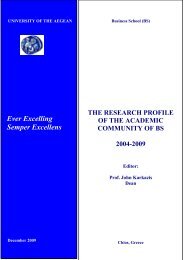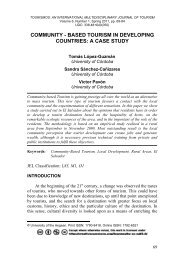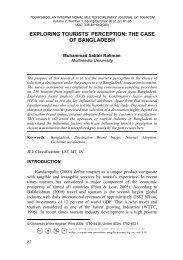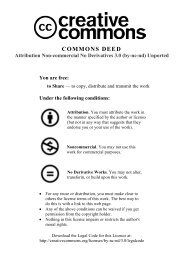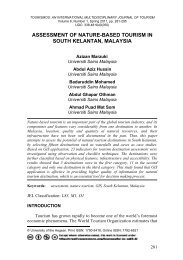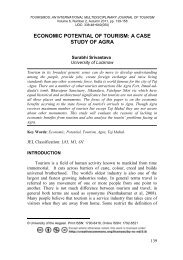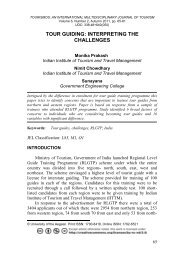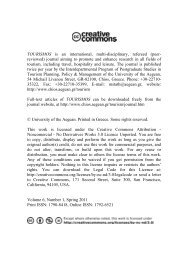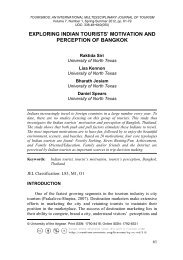GENDERED LEISURE: ARE WOMEN MORE CONSTRAINED IN ...
GENDERED LEISURE: ARE WOMEN MORE CONSTRAINED IN ...
GENDERED LEISURE: ARE WOMEN MORE CONSTRAINED IN ...
Create successful ePaper yourself
Turn your PDF publications into a flip-book with our unique Google optimized e-Paper software.
TOURISMOS: AN <strong>IN</strong>TERNATIONAL MULTIDISCIPL<strong>IN</strong>ARY JOURNAL OF TOURISMVolume 6, Number 1, Spring 2011, pp. 105-121UDC: 338.48+640(050)In leisure travel decisions, it is usually the male who holds the finaldecision making authority and the spouse and/or family are required toaccept and comply.In case of women, the results are equally divided with 50% womenreporting spousal and family dominance as a constraint and 50% reportingit to not be a constraint. An equal response indicates that half the womenoften conform to travel decisions made by their spouse and/or family. Forwomen who do not view spousal and/or family dominance as a constraint,it can be argued working women have now changed the balance structureof family decision making authority by virtue of gaining a level ofeconomic independence, that has empowered them to have a significantsay in decisions. Advocates of resource theory suggest that when womenmake substantial economic contribution to the household, power andcontrol in decision-making shifts in their favor (Blood and Wolfe, 1960;Blumstein and Schwartz, 1983; Green and Cunningham, 1976).Nowadays, out-earning women in the family may have more power.Independent working women have more authority and freedom in makingtheir leisure travel decisions and can even influence their spouse or familyin their own favor.Employment as a constraintEmployment status signifies working or non-working. Beingemployed or unemployed determines availability of discretionary financesfor travel and may also determine whether and how much time may beavailable for leisure travel. Therefore employment can be directlyassociated with financial and time constraints.The results indicate that majority of men i.e. 116(58%), compared tolesser women, i.e. 90(45%) perceive their employment status as the majorconstraint in making their leisure travel decisions.Table 4 Perception of Employment Status as a ConstraintMales (200) Females (200)Yes116(58.0%)No84(42.0%)Yes90 (45.0%)No110(55.0%)Working men associate time constraint with permanent employment.A majority of men reporting employment status as a constraint suggest,that because most of them are working, they have demands of theirprofession / occupation, that acts as a limitation of not allowing enoughdiscretionary time to undertake travel for leisure. Men are identified with115
Sonia Khanthe image the breadwinners and it is desired of men to take theiremployment seriously. For employed men, travel for leisure can beundertaken only during holidays from work. Thus, for men, timeconstraint due to professional obligations is an influential factornegatively affecting leisure travel.Relatively lesser women i.e. 90(45%) report employment to be aconstraint, as majority of women in the sample are non-working. Whileworking women view the time limitation due to paid employment as aconstraint, it is largely the non-working female population that associateslack of finances due to unemployment, as a major constraint to engage inleisure travel. If unemployment is related to financial constraints,especially, low-income employed women, unemployed or single parentsare more likely to view employment status as a constraint due to lowearning or savings.Most non-working females travel with their families, (parents orspouse) who finance their leisure travel. Thus, they do not perceiveunemployment as a constraint. Unemployment on the other hand,removes the time restrictions on one’s life, as women who are notengaged in paid employment feel free to take time off for vacationswhenever it suits them, their spouse and/or family.CONCLUSION AND IMPLICATIONSOf all the constraints studied in this study, the striking differencebetween men and women is found on perceiving their gender as aconstraint to travel for leisure. While more than 50% women report theirgender as a constraint, interestingly 100 % men report their gender to notbe a constraint. It can be thus concluded gender remains vital indetermining the liberty to travel. In leisure, women remain ‘relatively’more constrained than men.Though other socio-demographic constraints operate on bothgenders, the extent of their influence varies. For men, employment is amajor constraint to leisure travel, while for women, family responsibilitiesand spousal / family dominance exacerbate the gender constraint. The‘doing gender’, poses restrictions on the freedom of women.However, assessing the responses of females, it is noted that there isa near equal division of responses in all other factors being perceived as aconstraint or not. This clearly suggests that it can no longer be assumedthat women are always the disadvantaged gender. Times have changedand there is modernization of societies. With rapid social changes and116
TOURISMOS: AN <strong>IN</strong>TERNATIONAL MULTIDISCIPL<strong>IN</strong>ARY JOURNAL OF TOURISMVolume 6, Number 1, Spring 2011, pp. 105-121UDC: 338.48+640(050)better status being given to females, the trend towards gender equality ison increase in all spheres of life, leading to blurring of gender differences.Nevertheless, it is still the developed industrialized societies that aremoving at a faster pace in reducing gender gap biases. In developingsocieties, it is the more educated, working and urban women who havemoved ahead to achieve a status equal to their male counterparts. Thesewomen are the ones who do not perceive any gender, familial or socialrestrictions as constraints. However, the picture of the uneducated, ruraland poor women still reflects subjugation.Over the years, travel for leisure (a sphere considered important byboth genders, for individual well-being and existence) has seen asignificant increase of female participation. Both as a market segment intheir own rights and by providing greater household funds fordiscretionary spending, women now are a significant force in holiday andbusiness travel (Bhatia, 2001). This is accounted for by a number offactors like, changing and progressive attitude of society towards femaleeducation, better jobs, elevated status, growth of independent workingwomen segment, late marriages, changing nature of ‘Ethic of Care’ andjoint sharing of familial responsibilities between the spouses. Tracingsuch changes, it can be concluded that though men retain their position ofthe advantaged gender experiencing lesser constraints in leisure travelchoices, nonetheless, women are no longer disadvantaged, but remain‘relatively’ more constrained. In view of the significant social changes,research needs to further explore changing gender relations in society thatcan determine whether any one particular gender will remain constrainedfor long in any sphere of life.REFERENCESAnderson, M.L. (1993). Thinking about Women: Sociological Perspectives on Sexand Gender (3 rd Ed.). New York, Macmillan Publishing Company.Apostolopoulos, Y. & Sonmez, S. (2001). Working Producers, LeisuredConsumers: Women’s Experiences in Developing Regions. In Y.Apostolopoulos, S. Sonmez and D.J. Timothy (Eds.) Women as Producersand Consumers of Tourism in Developing Regions, Connecticut: PraegerPublishers.Barff, R., Mackay, D. & Olshavsky, R.W. (1982). A Selected Review of Travel-Mode Choice Models. Journal of Consumer Research, Vol. 8, pp.370-380.Bartos, R. (1982). Women and Travel. Journal of Travel Research, Vol. 20, No.4,pp.3-9.117
Sonia KhanBella, L. (1989). Women and Leisure: Beyond Androcentrism. In E. Jackson & T.Burton (Eds.) Understanding Leisure and Recreation: Mapping the Past.Charting the Future, State College, PA: Venture Publishing Inc.Bem, S.L. (1993). The Lenses of Gender: Transforming the Debate on SexualInequality. New Haven and London, Yale University Press.Bhatia, A.K. (2001). International Tourism Management. New Delhi, SterlingPublishers Private Limited.Birkett, D. (1989). Spinsters Abroad: Victorian Lady Explorers. New York,Blackwell Publishers.Blood, RO. & Wolfe, D.M. (1960). Husbands and Wives: The Dynamics ofMarried Living. New York, The Free Press.Blumstein, P.W. & Schwartz, P. (1983). American Couples: Money, Work, Sex.New York, William Morrow.Butler, K. (1995). Independence for Western Women through Tourism. Annals ofTourism Research, Vol. 22, pp.487-489.Carlos Monterrubio, J. (2009). Identity and sex: Concurrent aspects of gaytourism. Tourismos, Vol. 4, No.2, pp.155-168.Claveria, O. & Datzira, J. (2009). Tourism demand in Catalonia: Detectingexternal economic factors. Tourismos, Vol. 4, No.1, pp.13-28.Cross, S.E. & Hazel R.M. (1993). Gender in Thought, Belief, and Action: ACognitive Approach. In A.E. Beall and R.J. Sternberg (Eds.) ThePsychology of Gender, New York: Guilford Press.Davis, K. (1991). Critical Sociology and Gender Relations. In K. Davis and M.N.Oldersma (Eds.) The Gender of Power, New Delhi: Sage.Deem, R. (1990). Gender and Leisure-Past Progress, Future Prospects.International Sociological Association (ISA).DeCrop, A. (2005). Tourists’ Decision Making and Behavior Process. In A. Pizamand Y. Mansfeld (Eds.) Consumer Behavior in Travel and Tourism, NY:Haworth Press.Easlea, B. (1986). The Masculine Image of Science With Special Reference toPhysics: How Much Does Gender Really Matter? In J. Harding (Eds.)Perspectives on Gender and Science, Philadelphia: Falmer.Ferree, M.M. (1990). Beyond Separate Spheres: Feminism and Family Research.Journal of Marriage and the Family, Vol. 52, pp.866-884.Gentry, J.W. & Doering, M. (1970). Sex Role Orientation and Leisure. Journal ofLeisure Research, Vol. 11, pp.102-111.Gilligan, C. (1982). In a Different Voice: Psychology and Theory and Women'sDevelopment. Cambridge, MA, Harvard University Press.Gitelson, R. & Kerstetter, D. (1990). The Relationship between SociodemographicVariables, Benefits Sought and Subsequent VacationBehavior: A Case Study. Journal of Travel Research, Winter, pp.24-29.Greenberg, M.G. & Frank, R.E. (1983). Leisure Lifestyles. American BehavioralSciences, Vol. 26, pp.439-458.Green, R.T. & Cunningham, I.C.M. (1976). Empowerment Status, Feminine RolePerception and Family Purchasing Decisions. Journal of BusinessResearch, Vol. 4, pp.313-324.118
TOURISMOS: AN <strong>IN</strong>TERNATIONAL MULTIDISCIPL<strong>IN</strong>ARY JOURNAL OF TOURISMVolume 6, Number 1, Spring 2011, pp. 105-121UDC: 338.48+640(050)Henderson, K.A., Stalnaker, A. & Taylor, G. (1988). The Relationship betweenBarriers to Recreation and Gender-Role Personality Traits for Women.Journal of Leisure Research, Vol. 20 No.1, pp. 69-80.Henderson, K.A. (1994). Perspectives on Analyzing Gender, Women and Leisure.Journal of Leisure Research, Vol. 26, No. 2, pp. 119-137.Henderson, K.A. & Allen, K.A. (1991). The Ethic of Care: Leisure Possibilitiesand Constraints for Women. Society for Leisure, Vol. 14, No.1, pp. 97-113.Henderson, K.A. & Bialeschki, M.D. (1991). A Sense of Entitlement to Leisure asConstraints and Empowerment for Women. Leisure Sciences, Vol. 13,pp.51-56.Henthorne, T.L., George, B.P. & Williams, A.J. (2010). The evolving serviceculture of Cuban tourism: A case study. Tourismos, Vol. 5, No.2, pp.129-143.Jackson, E.L. (1991). Leisure Constraints/Constrained Leisure: Special IssueIntroduction. Journal of Leisure Research, Vol. 23, No.4, pp. 279-285.Kang, S.K. & Cathy H.C.H. (2003). Family Traveler Segmentation by VacationDecision-Making Patterns. Journal of Hospitality & Tourism Research,Vol. 27, No.4, pp.448-469.Kang, S.K. & Cathy H.C.H. (2004). Spousal Conflict Level and Resolution inFamily Vacation Destination Selection. Journal of Hospitality & TourismResearch, Vol. 28, No.4, pp.408-424.Keller, E.F. (1983). Feminism and Science. In E. Abel (Eds.) The Signs Reader:Women, Gender, and Scholarship, Chicago: University of Chicago Press.Kramer, L. (2004). The Sociology of Gender: A Basis of Introduction. Jaipur,Rawat Publications.Lorber, J. (1999). Embattled Terrain: Gender and Sexuality. In M.M. Ferree, J.Lorber and B.B. Hess (Eds.) Revisioning Gender, Thousand Oaks, CA:Sage Publications.Lindsey, L.L. (1994). Gender Role –A Sociological Perspective (2 nd Ed.). NewJersey, Prentice Hall Inc.Mayo, E. & Jarvis, L. (1981). The Psychology of Leisure Travel. Boston, CBIPublishing.Matheison, A. & Wall, G. (1982). Tourism: Economic, Physical and SocialImpacts. Harlow, UK, Longman.Miller, C. & Swift, K. (1991). Words and Women: New Language in New Times.New York, Harper Collins.Middelton, V.T.C. (1988). Marketing and Travel and Tourism. Oxford, UK,Heinemann.Moutinho, L. (1987). Consumer Behavior in Tourism. European Journal ofMarketing, Vol. 21, No.10, pp.1-44.Myers, P.B. & Moncrief, L.W. (1978). Differential Leisure Travel DecisionMaking between Spouses. Annals of Tourism Research, Vol. 5, No.1,pp.157-165.119
TOURISMOS: AN <strong>IN</strong>TERNATIONAL MULTIDISCIPL<strong>IN</strong>ARY JOURNAL OF TOURISMVolume 6, Number 1, Spring 2011, pp. 105-121UDC: 338.48+640(050)Sonia Khan (khansonia@hotmail.com) is an Assistant Professor ofTourism at the Himachal Pradesh University, Institute of Vocational(Tourism) Studies, Himachal Pradesh, Summer Hill, Shimla – 171005,India.121




